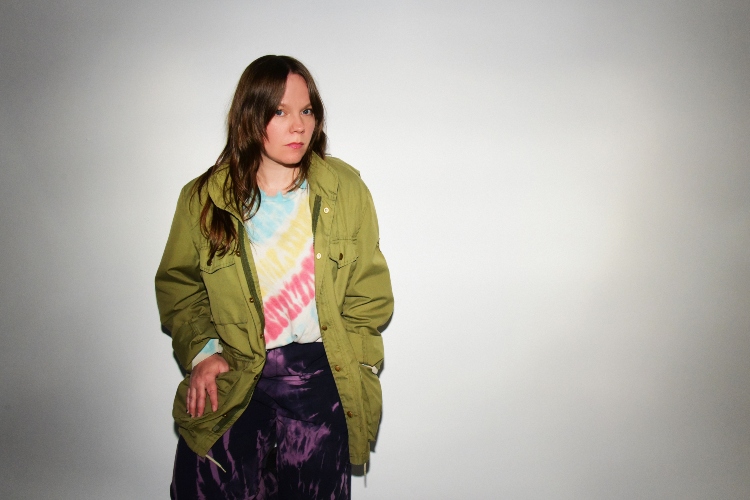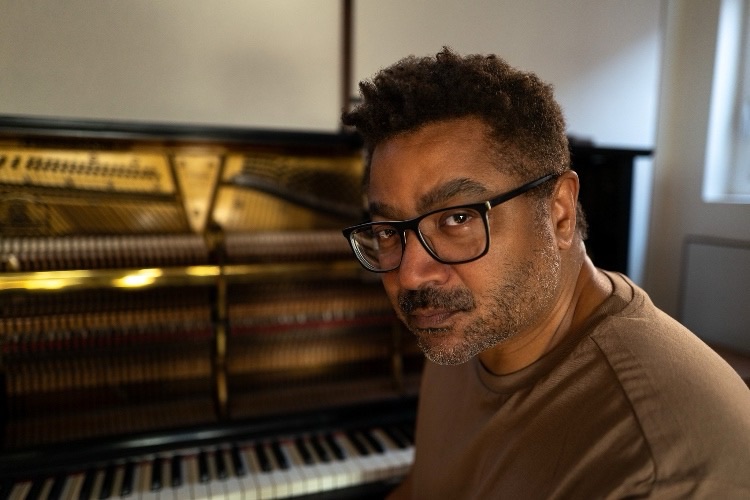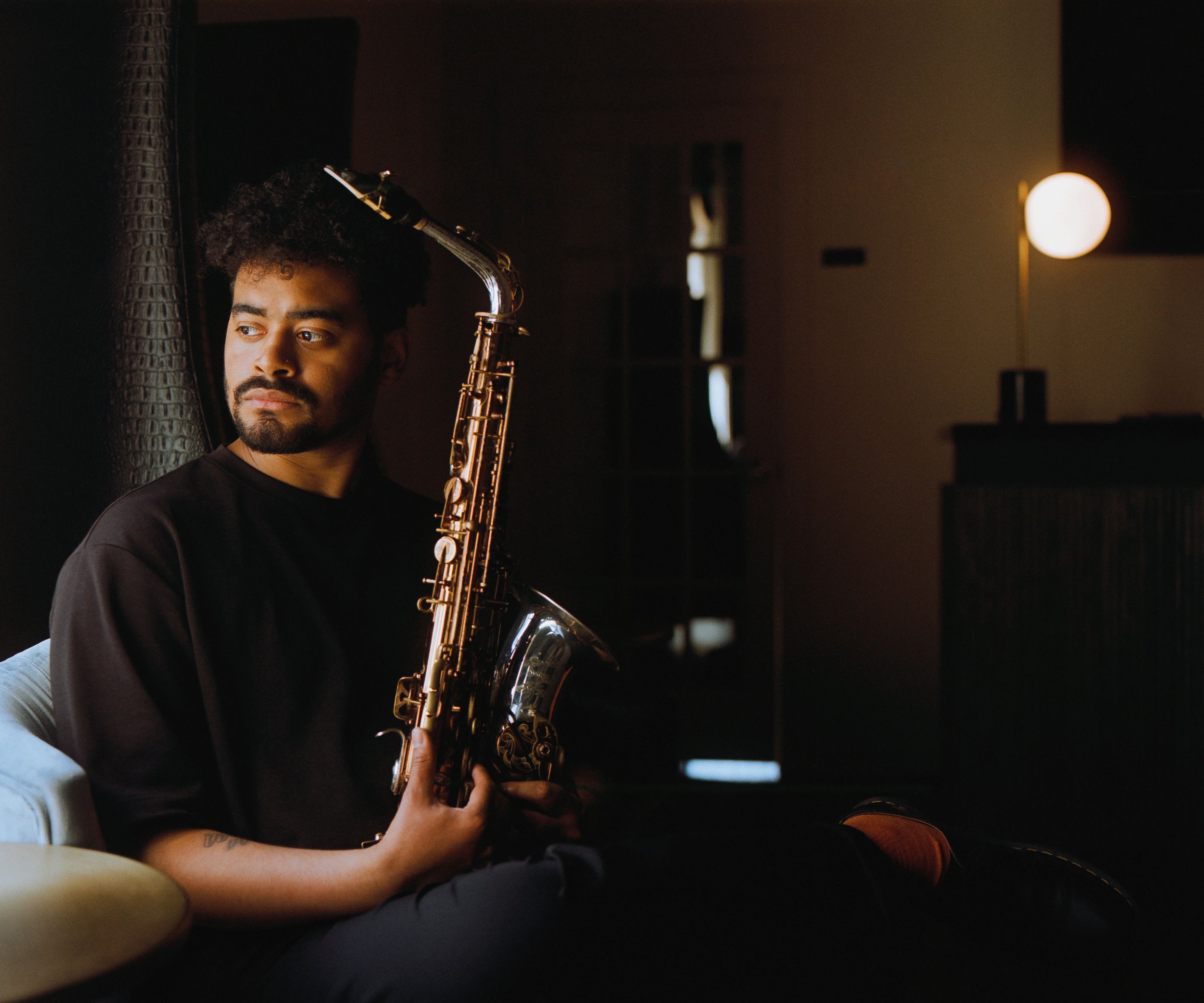Weaving: A Conversation with Janel Leppin
|
Getting your Trinity Audio player ready...
|
As an art form, weaving requires different threads to combine into one to create a sturdier whole cloth. How the threads are combined affects the characteristics of the end product. It is appropriate that cellist Janel Leppin is also a weaver by trade, as one can hear a direct application of the concepts from her textile work into her music. This is particularly evident in her two newest recordings. The first, New Moon in the Evil Age (Cuneiform, 2024), out under the name Janel and Anthony, a collaboration with her consistent musical partner (and husband), guitarist Anthony Pirog. It also features Devin Hoff on bass and Dr. Ali Analouei on daf – a Middle Eastern frame drum – and tombak – an Iranian goblet drum. The second, Ensemble Volcanic Ash’s To March is to Love (Cuneiform, 2024), presents a larger ensemble with Leppin, Pirog, drummer Larry Ferguson, bassist Luke Stewart, and saxophonists Sarah Hughes and Brian Settles.
Despite the significantly different instrumentation between the two ensembles, shared threads emerge. One can hear Leppin’s background as a classically trained artist in how New Moon‘s “Slight Sense” and To March’s “Sateatime” draw direct inspiration from the proto-minimalism of Erik Satie’s furniture music. Her affinity for the music of different cultures is also evident. With Anthony, it takes the form of Middle Eastern percussion and Leppin’s use of the Japanese koto. With Ensemble Volcanic Ash, influence is derived directly from the lineage of Black American music, specifically jazz, with a nod to the late great Abdul Wadud. Hues of more popular music also appear, from the 80s synth-pop vibe of “Evil Age” to the punkishness of “Union Art.” But rather than letting these strands stay insulated, they are intertwined into new patterns. From these patterns, both albums provide fascinatingly rich tapestries of Leppin’s musical ideas.
Leppin is hardly a stranger to combining diverse thoughts. A central figure in Washington D.C.’s music scene for over two decades, her other works have ranged from solo cello to singer-songwriter. Her sideperson work has covered psych-rock, experimental music, art-punk, and more.
PostGenre: The last Janel and Anthony album, Where is Home (Cuneiform, 2012), came out several years ago. Why did it take so long to make another Janel and Anthony album?
Janel Leppin: We are both incredibly busy making many different kinds of music. Inevitably, we would each be involved in other projects. I toured for fourteen years as a side person (bass, keyboards, cello, vocals) while Anthony was working on several different projects. It’s also very expensive to go into the studio. Despite all of that, however, creating another Janel and Anthony album was always simmering in the back of our minds. We chipped away at the album over time. The question then became how to best release New Moon in the Evil Age. We weren’t sure what would be the most digestible way. Thankfully, our fan base is very open and interested in creative music as a whole. Steve Feigenbaum at Cuneiform weighed in, and we decided to release it as a double album because it felt to all of us that the two parts that otherwise would have been separate – New Moon and Evil Age- should be combined into one.
PG: You use a modified cello on New Moon in the Evil Age. What can you share about the instrument?
JL: Back in 2000, I went to the Netherlands to study with a cellist named Saskia Rao-de Haas, who specialized in North Indian classical music in the dhrupad tradition. I first studied with her in Amsterdam and then in New Delhi. She created this instrument with a luthier from Haarlem, Netherlands, who added eight resonant strings beneath the fingerboard crafted specifically for Hindustani classical music. She offered for me to buy her first version of that modified cello. I briefly studied with her as part of a minor in “world music” a term for which I feel conflicted. Regardless, I learned a lot from Saskia, and I use the instrument occasionally on recordings. I included it on a Rose Windows album [Sundogs, (Sub Pop, 2013)], on some of Eyvind Kang’s recordings, and Janel and Anthony’s first album (self-release, 2007/Cricket Cemetery) features it as well.
PG: On “Boom Boom”, you also play the koto. How did you start playing that instrument, and do you feel the experience of playing the koto has influenced how you approach the cello?
JL: I studied the koto as part of my minor in college. There is a koto association in D.C., and I was studying with the president of that group, Mrs. Okamoto. I’m obsessed with the tuning of the koto. The instrument has thirteen strings and is similar to, but not quite, a minor pentatonic scale. I’ve played koto scales on my cello ever since. I find it to be a very beautiful approach.
PG: “jaimie’s Song” is dedicated to the late jaimie branch. Do you have a favorite memory of her?
JL: Oh gosh, there are so many. Although we spent lots of time together over the years since we met at Heaven in Chicago I think the last time I played with jaimie was at a duo show I had with Susan [Alcorn] at the Red Room in Baltimore. After the show, many of us, jaimie included, went to someone’s house and jammed. It was a very special night. Jarret Gilgore said he found the recording recently.
Another favorite period was during COVID when we worked remotely on a smoke cloak with her artwork for my small batch fashion label that I ran. It’s out in the world now thanks to Kate Branch, jaimie’s sister. She knew how special that project was, which jaimie and I couldn’t get finished with our limited connections and experience in the field. It was a big undertaking, but Kate is in the fashion world and was able to bring it to life. I’m so happy we made that dream that jaimie and I worked so hard on together finally come true in her name. I just wanted to make one for her mother that she could wrap herself in with her daughters’ artwork, so making twenty-five of them was incredible to me. What a collaborative feat it was.
PG: Since you mentioned Susan Alcorn, how did that collaboration come together?
JL: Several years ago, we played [the experimental free improvised music festival in Baltimore], High Zero together. Susan and I complimented each other and decided to play after the festival. Ultimately, we recorded a duo record together, Sister Mirror (Atlantic Rhythm, 2020). Half is free improvisation, and the other half is [Heitor] Villa-Lobos’ “Bachianas Brasileiras No. 1.”
After that, she asked me to curate and arrange her music for her residency at the Issue Project Room. I chose a dream group – Anthony, Jessika Kenney on voice, Eyvind Kang on viola, Skúli Sverrisson on bass, Doug Wieselman on clarinet/bass clarinet, and myself. I struggled to lead two rehearsals of such beautiful, often rubato music. But the actual concert was complete magic. It was a huge deal for me to get that recording (The Heart Sutra (Ideologic Organ/Editions Mego, 2020) out to the world because I had been listening to it for so many years. People often think that Susan is playing on it when she is not, and I take that as a compliment for the ensemble.
Susan’s music is very special to me. She’s a teacher and a friend. I have learned a lot from her, including some years of grappling with how to play pedal steel [guitar]. I studied her music on the instrument off and on between projects over the years.
PG: Going back to the new albums, in addition to the Janel and Anthony record, New Moon in the Evil Age, you will concurrently release To March is to Love with Ensemble Volcanic Ash. How did that group initially come together?
JL: In 2007, I had my first performance as a band leader of a jazz group. I was obsessed with [Julius Hemphill’s] Dogon A.D. (Freedom, 1972). One song we played was the title song from that album. That was my first entry into the world of being a bandleader.
Playing Abdul Wadud’s music has been extremely important to me as a cellist. As a classically trained player through college, much of my study after college focused on the way he approached his accompaniment. I have also revered David Baker’s jazz cello instruction. I wish I could have known both of them, but studied mainly with Anthony and while onstage playing with people here in D.C.
PG: You even have a track on To March is to Love titled “Ode to Abdul Wadud.” How did you first become aware of him?
JL: Through Anthony. We got together around 2005, and he has shown me a lot of important music over the years. At first, we would jam together. Through that experience, Anthony showed me that I could play with electronics if I wanted. That greatly interested me because I couldn’t play the cello for a period in college. I had wrecked my upper body and had to quit for a year. Applying effects and electronics to my instrument helped me stay in music. They helped me work around the pain to a degree while helping me expand my sound. After playing so many instruments just to keep going in music, I’m at the point where I can practice cello more. Thanks to a lot of manual physical therapy, that is where I am focused again. That’s another reason it has taken so long to put Ensemble Volcanic Ash out. It also affected the period between Janel and Anthony records, too. Thankfully, Anthony has been encouraging from day one.
PG: How did you determine the unique instrumentation for Ensemble Volcanic Ash?
JL: It’s gone through several transformations over the years. I think the group is dependent on having the right players. I played in orchestras for many years, and from that, I understand how important timbre is to an ensemble. I started booking residencies at Rhizome to pay my musicians for rehearsals live, in front of our awesome community here. I did that for both records. It created a buzz and some immediacy and pressure, which I enjoy. The people in the group have been playing with me for a very long time in various contexts, and they are all incredible. We have hit our stride now, I think. I miss having [harpist] Kim [Sator] with us, but she had some personal family things going on that wouldn’t allow her to travel to record and tour, but at least she is on our first record.
PG: Other than Kim’s absence, what do you think most sets this second record apart from the first one?
JL: With this new one, I tried to make things a little more concise. The last record had a huge amount of free improvisation. I omitted a lot of improvisation on this recording, which I don’t like to do, but I also like to vary records. I wanted one soloist per piece so everyone could fully express themselves and not pass the solos around.
PG: How does Erik Satie fit in with it all? Both of the new albums – “Sateatime” on To March is to Love and “Slight Sense” on New Moon in the Evil Age draw influence from him.
JL: He rejected academics in some ways, which I like. He’s kind of a punk to me. I guess he had bad grades and was a joker in a way. But I think it was all his way of going for something different.
PG: Changing gears, during the pandemic, you lived a transient lifestyle for a year. Do you have any sense of how that may have impacted your music?
JL: Location is so important to us. Most of our records are personal and very tied to wherever our home base is. Anthony grew up in Carmel Valley, [California]. And we ended up – for the same price as where we were renting in D.C.- finding a place to live out there, for almost a year. After we were out there, we were also invited to take part in a residency at Witch House in San Francisco. We spent a few of those months writing and recording in that house some of the songs that appear on the Janel and Anthony instrumental record. It was a gorgeous place, but the shack we rented was being demolished the next year, so we knew it was going to be a very short-term solution. Both of us thought, “Well if this is the end of the world, I guess we want to be here.” Thankfully, of course, the world kept going and after those eleven months, we moved back to D.C.
I’m glad because The Messthetics needed Anthony. Moving back also let me realize these new albums. There are many interesting intellectual people here who are top experts in their fields and have lived here for periods of time. It’s a very transient place, and there are always new people to play for. I find the people are very open to art and music in D.C. It’s an awesome place to have concerts. We have a very strong community here, and we’re very happy to be part of it.
Janel and Anthony’s New Moon in the Evil Age and Ensemble Volcanic Ash’s To March is to Love will be released on Cuneiform Records on June 28, 2024. Both albums are available on Bandcamp. More information on Janel Leppin can be found on her website.



